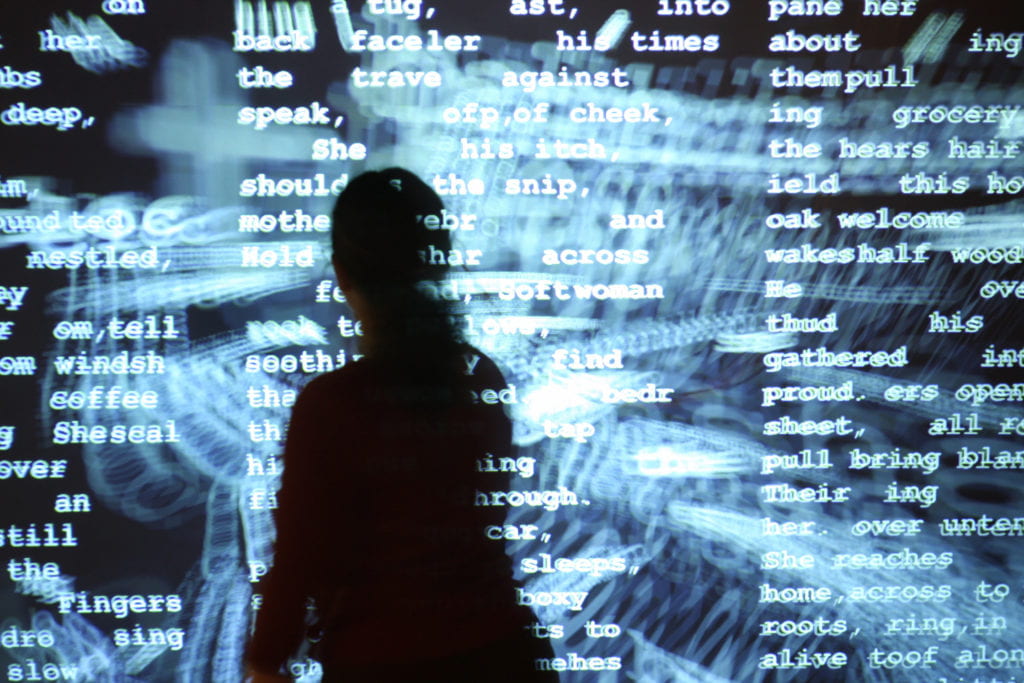Beall Center marks 10 years on art's edge
For a decade, UC Irvine’s innovative Beall Center has been showcasing technology-based work and challenging perceptions.
Art is often described as “cutting-edge.” But UC Irvine’s
Beall Center for Art + Technology
is beyond that. It’s on the “bleeding edge,” according to
Antoinette LaFarge,
associate dean for graduate affairs at the Claire Trevor School of the Arts and associate professor of digital media.
She should know. She’s been with the center from the beginning.
This fall — 10/10/10 to be exact — the center will celebrate 10 years
of redefining gallery and exhibition space by merging art and
technology.
Being on the edge, however, can often mean being misunderstood — at least until others catch up.
In 2000, LaFarge and Robert Nideffer, studio art professor, curated the center’s first show,
“Shift-Ctrl,”
which focused on computers, games and art.
“It was the first in the country to take computer gaming seriously — showing that games and art are not separate,” LaFarge says.
The exhibit took place during a very different time. “In 2000, the
major media and cultural climate were portraying computer games as bad
and violent,” she says. “So to dedicate an inaugural show to gaming as
art was a huge risk — and quite visionary.”
Visionary
indeed. A decade later, popular culture has changed dramatically, and
universities — including UCI — have begun to make gaming an academic
field of study.
Promoting
new forms of creative expression is part of the center’s mission.
Rockwell Corp. funded the facility in honor of retired Chairman Don
Beall and his wife, Joan, the core idea being to merge their lifelong
passions — business, engineering and the arts — in one place.
The
center is a web of invisible electronic infrastructure: Electrical
outlets are everywhere, and it’s “networked to the max,” according to
LaFarge. The windowless black box is a perfect platform for the
extraordinary endeavors showcased there.
Visitors have been invited to challenge their perceptions through luminous, intelligent blimps
(“ALAVs 2.0,”
by Jed Berk, 2007); everyday objects transformed into roving electronic beings that respond to human attention (“EX-I-09,” by
Shih Chieh Huang,
2009); instruments that need no musicians
(“LEMUR,”
by Eric Singer, Jeff Feddersen, Milena Iossifova, Bil Bowen and Luke DuBois, 2005); and interactive video dancing
(“Active Space: Interactive Videodance,”
by Lisa Naugle and John Crawford, with Frederic Bevilacqua, 2004). Such highly acclaimed artists as
Nam June Paik
and
Jennifer and Kevin McCoy
have also had shows at the Beall.
Because of the exhibits’ unconventional approaches and materials, “there’s been a resistance to this kind of work,” says
David Familian,
the center’s artistic director and curator. He’s trying to change that
with the pieces he selects for exhibition. “First of all, I want it to
look like art — not just technology. It’s not ‘Gee whiz, look what this
thing can do,'” he says.
In addition, Familian titles exhibits without referencing technology
to avoid any preconceptions. He wants people to be open to the work, not
distracted by the latest electronic gadgetry or gimmickry. Calling an
exhibit “Live” or “Emergence” leaves a lot of room for imagination and
interpretation.
“The
tension is always between not having the technology overpower the
concept and the visual quality of the work,” Familian says. “Technology
expands the expressivity of what you’re doing, but what you’re doing is
the same thing that every artist does: You’re manipulating materials to
create meaning.
“It’s like photography was in the 1970s. Museums were not showing
photography. They had departments that would separate photography from
the rest of the arts. Now there’s more integration. We’re striving
toward that. It can be done — it just takes time.”
Eleanore Stewart,
the center’s director from 2004 to 2009, reflects on what has already
been accomplished there: “Over the last 10 years, the Beall Center
played a critical role in the emerging field of digital arts by
providing the advanced technical space and support to exhibit work when
other U.S. museums and galleries could not.”
Involving
the surrounding community is also part of the center’s mission. By
hosting “Family Days” for each exhibit, the center encourages audiences
of all ages to open their minds to the media arts with child-friendly
activities related to the art.
“The
best part for me was the opportunity to work with so many wonderfully
imaginative artists and to see the faces of visitors light up in
amazement when they saw the exhibitions,” Stewart says.
To kick off the one-decade celebration, artist
Rafael Lozano-Hemmer
will show his “Pulse Room” and “Pulse Index” for the first time in the
U.S. at the Beall Center. The opening reception will take place 6-9
p.m. Thursday, Sept. 30, and the exhibit runs through Jan. 22. A free
“Experimental Media Art Festival” also marks the center’s 10-year
anniversary 1-8 p.m. Sunday, Oct. 10, with music, exhibits and
activities for all ages.
Lozano-Hemmer’s
work has been exhibited internationally, including at the opening
ceremonies of the 2010 Winter Olympic Games in Vancouver. His “Pulse”
installations incorporate sensors that detect participants’ heartbeats,
to which lights, shadows and water are then synchronized. Quite
literally, visitors become the art.
Just as you’d expect from an art center on the “bleeding edge.”








